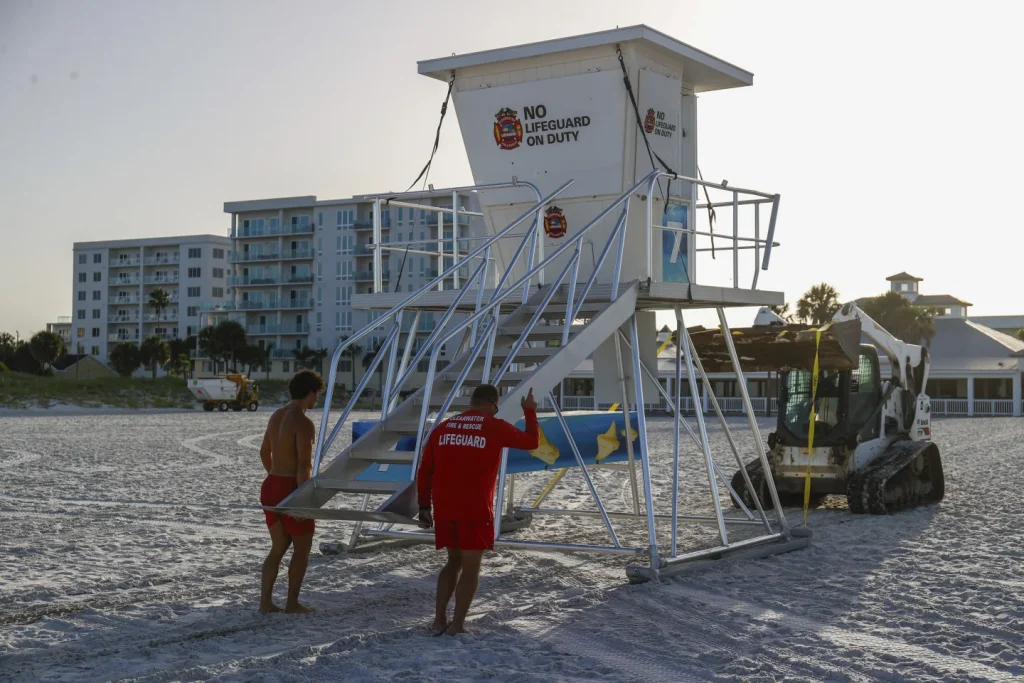The emergence of Tropical Storm Debby from a tropical depression represents a significant development in the ongoing 2024 Atlantic hurricane season, highlighting the precarious relationship between climatic phenomena and human habitation.
As Debby hails from the Caribbean, its trajectory threatens the delicate ecological and structural fabric of the southeastern United States, particularly Florida.
This analysis aims to elucidate the implications of this storm, addressing its potential impacts on the affected regions and the broader implications for disaster preparedness and response.
As reported by the National Hurricane Center, Tropical Storm Debby developed north of Cuba and is characterized by maximum sustained winds of 40 mph (65 kph).
The storm is currently situated approximately 100 miles (160 kilometers) west-southwest of Key West, Florida, moving northwest at a speed of 14 mph (22 kph).
The meteoric rise of Debby from a tropical depression to a storm capable of hurricane intensity underscores the dynamic nature of tropical weather systems, particularly in regions where sea surface temperatures are exceptionally high.
Such conditions create an environment conducive to rapid intensification, which forecasters anticipate will occur as Debby approaches the Gulf Coast.
The storm’s projected path indicates a landfall along Florida’s Gulf Coast, anticipated to occur as early as Monday. The implications of Debby’s arrival are multifaceted.
Forecasters predict that coastal areas will experience significant meteorological onslaught, with an estimated 6 to 12 inches (150 mm to 300 mm) of rain, and in isolated instances, potentially up to 18 inches (450 mm).
The region’s vulnerability to flooding is exacerbated by its geographic and hydrological characteristics; Florida’s flat terrain is susceptible to inundation even in mild weather.
Thus, the impending rains pose a substantial risk for flash flooding and river overflow, particularly in areas that are ill-equipped to manage such volumes.
The forecasted storm surge of 2 to 4 feet (0.6 to 1.2 meters), with localized projections indicating a surge of up to 7 feet (2.1 meters) in the more sparsely populated Big Bend area, presents another layer of danger.
This surge can lead to life-threatening inundation, particularly in vulnerable coastal communities. Local governments, recognizing the gravity of this situation, have initiated evacuation protocols, with mandatory evacuations declared in Citrus and Levy counties.
The swift action taken by local officials demonstrates an acute awareness of the potential consequences of tropical storms, elevating the importance of proactive disaster management practices.
Although Florida is in the eye of the storm, neighboring states, specifically Georgia, South Carolina, and North Carolina, are also on alert.
Meteorological projections suggest that as Debby moves inland and potentially stalls or meanders along the southeastern coastline, communities far from the initial landfall may still experience significant rainfall and associated hazards.
This regional interconnectedness underscores the necessity for comprehensive disaster planning that transcends state lines, as hydrological outcomes are often influenced by factors well beyond the storm’s immediate vicinity.
The advances in forecasting technologies, such as those leveraged by the National Hurricane Center, serve as vital tools in preparing the public and local authorities for impending storms.
However, the unpredictability inherent in weather patterns necessitates an adaptable and responsive approach to crisis management.
Communities must be equipped not only to combat immediate threats from storms but also to recover from the aftermath, which often includes power outages, infrastructural damage, and emotional distress among residents.
In conclusion, the approaching storm, Tropical Storm Debby, epitomizes the increasing frequency and intensity of meteorological phenomena influenced by climate change.
The anticipated impacts on Florida and the southeastern United States serve as a reminder of the vulnerabilities inherent in coastal living, particularly in relation to extreme weather events.
Local governments, disaster management agencies, and the public must cultivate a culture of preparedness and resilience, utilizing the lessons learned from Debby to inform strategies for future storms.
As demonstrated by the unfolding events surrounding Debby, the imperative to act—and act wisely—has never been more pronounced. The future of coastal communities hinges not only on the immediate responses to such threats but also on long-term strategies that enhance their ability to withstand and recover from the ravages of nature.
The impending threat of tropical storms has spurred serious preparations across Florida as Governor Ron DeSantis has declared a state of emergency for 61 of the state’s 67 counties.
This decisive action comes in response to the anticipated impacts of Tropical Storm Debby, which bears the potential to disrupt lives, damage property, and strain emergency response systems.
Complementing this state of readiness, Governor Brian Kemp of Georgia has similarly proclaimed an emergency status for his state. This collaborative approach underlines the gravity of the situation, as the impact of severe weather transcends state boundaries, necessitating joint preparedness efforts.
Amid these governmental declarations, federal support has been mobilized, with the White House informing the public of active communication between federal officials, including the Federal Emergency Management Agency (FEMA), and state authorities.
FEMA has proactively “pre-positioned” vital resources, such as water and food supplies, ensuring that they are readily available for communities affected by the storm. This logistical preparedness is crucial in mitigating the challenges that might arise during and after the storm’s passage.
Preparations are not limited to municipal efforts; private enterprises are also taking significant precautions. Christina Lothrop, the general manager of Blue Pelican Marina in Hernando Beach, reported a noticeable uptick in activity as residents rushed to launch their boats ahead of the storm.
Despite the hustle and bustle, she described the atmosphere as unusually “normal,” reflecting a level of ambivalence that can often accompany repeated instances of severe weather.
Nonetheless, her team has been diligently securing boats, organizing tools, and reinforcing the marina’s infrastructure to withstand the expected conditions. This attentiveness is not merely a precaution; historically, many marinas have incurred substantial losses when storms strike without adequate preparation.
In contrast to the proactive measures observed, some residents, like Betti Silverman from Crystal River, remain skeptical about evacuation orders, drawing from their lived experience of weathering storms in Florida.
Having recently moved into a waterfront home that had previously been flooded, Silverman expressed her belief in the unpredictability of the storm’s impact, stating, “We’ve been in Florida our whole lives – in South Florida – so hurricanes are not really a big, big thing.”
Such sentiments highlight the complex relationship individuals have with natural disasters—often shaped by past experiences, community norms, and a deep-seated sense of resilience.
Furthermore, this storm’s proximity has prompted infrastructure projects to temporarily halt or adapt to the forthcoming weather.
For example, construction crews in Tampa Bay have taken precautionary steps by relocating floating cranes and securing equipment, ensuring that essential works do not exacerbate the challenges posed by the incoming storm.

These proactive measures reflect an understanding that, during severe weather events, even minor oversights can escalate into significant hazards.
In conclusion, the coordinated response involving state and federal authorities aimed at preparing Florida for Tropical Storm Debby encapsulates a broader narrative of adaptive preparedness in the face of natural disasters.
Through communal and governmental efforts, resources are mobilized, infrastructures are fortified, and individuals are encouraged to take proactive measures to protect their homes and families.
This multilayered response exemplifies the critical importance of preparedness, resilience, and collective action in mitigating the impacts of flooding and other storm-related adversities.
